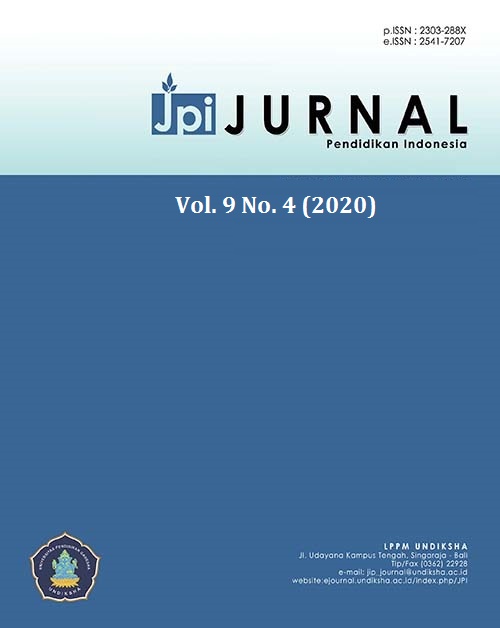Teaching Materials of Thematic Comics in the 2013 Curriculum Learning in Basic Schools
DOI:
https://doi.org/10.23887/jpi-undiksha.v9i4.20908Keywords:
Teaching Materials, Comics, ThematicAbstract
Learning material books that are used today, especially in elementary schools (SD) are still full text, resulting in the low motivation of students to read them because they are not or not interesting. This study aims to develop thematic comics as learning materials in the 2013 Curriculum with the theme "Events in Life" and sub-theme 1 "Occupation of the Occupation of Nationality" in the fifth-grade elementary school. This research uses the Research and Development (R&D) method of the Dick and Carey model which consists of 10 stages. The study was conducted in fifth grade students in five elementary schools in Majalengka Regency. These results state that the thematic comic learning materials developed are suitable for use in the learning process in elementary school and show very good responses. The advantage of this thematic comic learning material is that it can integrate various subject matter into a theme that is presented into a story with various character characters in it. This comic learning material has an attraction for students because it is different from ordinary reading books in which it presents visualization of imaginative and colorful images.
References
Aeni, W. A., & Yusupa, A. (2018). Model Media Pembelajaran E-komik Untuk SMA. Kwangsan, 6(1).
Aisami, R. S. (2015). Learning styles and visual literacy for learning and performance. Procedia-Social and Behavioral Sciences, 176, 538–545.
Al Ghazali, M. I., Hanifah, N., & Sudin, A. (n.d.). PENERAPAN MEDIA KCS (KOMIK CERITA SEJARAH) PADA MATERI TOKOH-TOKOH SEJARAH PADA MASA HINDU-BUDHA, DAN ISLAM DI INDONESIA UNTUK MENINGKATKAN HASIL BELAJAR SISWA KELAS V. Jurnal Pena Ilmiah, 1(1), 661–670.
Alghazali, M. I. (2019). Pengaruh Media Cerita Bergambar Dan Literasi Membaca Terhadap Hasil Belajar Siswa Sekolah Dasar. JTP-Jurnal Teknologi Pendidikan, 21(3), 269–282.
Arini, F. D., Choiri, A. S., & Sunardi, S. (2016). The Use of Comic As A Learning Aid To Improve Learning Interest of Slow Learner Student. European Journal of Special Education Research.
Arroio, A. (2011). Comics as a narrative in natural science education.
Bingham, T., Reid, S., & Ivanovic, V. (2016). Paint me a picture: translating academic integrity policies and regulations into visual content for an online course. International Journal for Educational Integrity, 12(1), 1–13.
Dessiane, S. T., & Hardjono, N. (2020). EFEKTIVITAS MEDIA PEMBELAJARAN CERITA BERGAMBAR ATAU KOMIK BAGI SISWA SEKOLAH DASAR. Jurnal Pendidikan Dan Konseling (JPDK), 1(2), 48–53.
Dick, W. C. (81 C.E.). L. & Carey, J.(2009). The systematic design of instruction. NJ: Upper Saddle River. Pearson.
Dunita, W. M., & Asril, Z. (2019). PENGARUH MEDIA KOMIK TERHADAP HASIL BELAJAR PKN PESERTA DIDIK KELAS III SD NEGERI 27 KOTO BARU KABUPATEN PESISIR SELATAN. Tarbiyah Al-Awlad, 9(1), 85–98.
Kerneža, M., & Košir, K. (2016). Comics as a literary-didactic method and their use for reducing gender differences in reading literacy at the primary level of education. Center for Educational Policy Studies Journal, 6(2), 125–149.
Krisdiana, I., Apriandi, D., & Setiansyah, R. K. (2014). Analisis kesulitan yang dihadapi oleh guru dan peserta didik sekolah menengah pertama dalam implementasi Kurikulum 2013 pada mata pelajaran matematika (studi kasus eks-karesidenan Madiun). JIPM (Jurnal Ilmiah Pendidikan Matematika), 3(1).
Krishnan, S., & Othman, K. (2016). The effectiveness of using comic to increase pupils’ achievements and higher order thinking skills in science. International Journal of English and Education, 5(3), 281–292.
Krissandi, A. D. S., & Rusmawan, R. (2015). Kendala guru sekolah dasar dalam implementasi Kurikulum 2013. Jurnal Cakrawala Pendidikan, 34(3).
Manchester, A. (2017). Teaching Critical Looking: Pedagogical Approaches to Using Comics as Queer Theory. SANE Journal: Sequential Art Narrative in Education, 2(2), 2.
McCloud, S., & Martin, M. (1993). Understanding comics: The invisible art (Vol. 106). Kitchen sink press Northampton, MA.
Merc, A., & Kampusu, Y. (2013). The effect of comic strips on EFL reading comprehension. International Journal on New Trends in Education and Their Implications, 4(1), 54–64.
Poggiali, J., & Farrell, R. (2014). Comics to the rescue: finding innovative applications for library digital learning objects.
Raiyn, J. (2016). The Role of Visual Learning in Improving Students’ High-Order Thinking Skills. Journal of Education and Practice, 7(24), 115–121.
Weber, K. C., SALDANHA, T. C. B., SILVA, K. K. D. E. S. E., SANTOS, P. M. M., SOUZA, D. D. D., & ARROIO, A. (2013). Introducing comics as an alternative scientific narrative in chemistry teaching. Batı Anadolu Eğitim Bilimleri Dergisi, 4(8), 1–14.
Widyastono, H. (2017). Pemanfaatan Teknologi Informasi dan Komunikasi pada Sekolah Menengah Pertama Negeri Akreditasi A di Provinsi Jawa Timur. Kwangsan, 5(1).
Wong, K. C. (n.d.). Reflection on Effective Communication for Learning & Teaching at Higher Learning Institutions.
Yuastutik, I. (n.d.). Upaya Peningkatan Kinerja Guru melalui Pelatihan Menggunakan Metode Gambar Pikiran Plus untuk Meningkatkan Proses Belajar Mengajar di SD Inklusif. Kwangsan, 1(2).
Downloads
Published
Issue
Section
License
Authors who publish with the Jurnal Pendidikan Indnesia agree to the following terms:
- Authors retain copyright and grant the journal the right of first publication with the work simultaneously licensed under a Creative Commons Attribution License (CC BY-SA 4.0) that allows others to share the work with an acknowledgment of the work's authorship and initial publication in this journal.
- Authors are able to enter into separate, additional contractual arrangements for the non-exclusive distribution of the journal's published version of the work (e.g., post it to an institutional repository or publish it in a book), with an acknowledgment of its initial publication in this journal.
- Authors are permitted and encouraged to post their work online (e.g., in institutional repositories or on their website) prior to and during the submission process, as it can lead to productive exchanges, as well as earlier and greater citation of published work. (See The Effect of Open Access)








